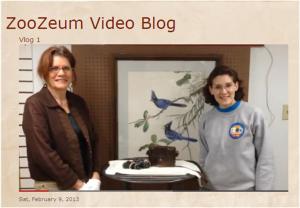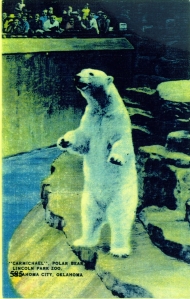I was honored to interview these four wonderful artists who use the zoo as a resource for creating their nature-inspired paintings and drawings. ~Amy
Jan McGuire, Acrylic Paintings
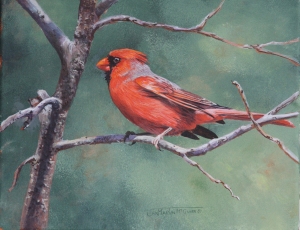
Jan McGuire painting, printed with permission.
Jan McGuire (Bartlesville) paints so that viewers can step into a scene and feel as if they are there. Not surprisingly, she uses photographs and travel experiences to make her acrylic art very realistic.
“I study nature. I go outside every day. Nature is so diverse that I never have trouble coming up with ideas to paint,” McGuire said.
McGuire, who specializes in bird and mammal paintings, has exhibited her art globally, from Tanzania to the Smithsonian. She and her husband, a professional wildlife photographer, visit the zoo multiple times each year, seeking to capture the fine details that cause people to step into a scene, to feel the velvet moss, and to smell the flowers….
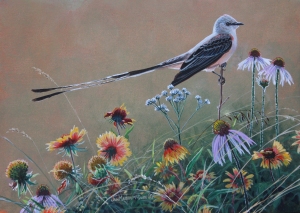
Jan McGuire painting, printed with permission.
“What I appreciate about the Oklahoma City Zoo is the bird aviary in Oklahoma Trails. So many zoos focus on non-North American species. I’m fortunate enough to travel to Africa every year, so I’m much more interested in seeing native species up close. Songbirds are hard to view from a distance, but in the aviary, the birds are acclimated enough to people that we can get great photos.”
Her scissor-tailed fly catcher painting is a direct result of a visit to the zoo. She added tall grass prairie wildflowers to create an accurate habitat for the background.
“We have great wildlife in this state,” McGuire said. “When people see us at the zoo with our big cameras, they always ask us animal questions. I can’t help but educate people about animals. My husband has to keep reminding me, ‘You don’t work here.’”
Jay Tracy, Acrylic Paintings
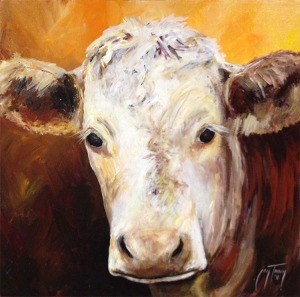
Jay Tracey painting, printed with permission.
It’s no surprise that Jay Tracy (Oklahoma City) became a painter, because his parents have owned an art company since 1968. After experimenting with different mediums since childhood, he now specializes in realism, landscapes and animal portraits.
“My entire life has revolved around art, all types of art,” Tracy said. “My most popular commissioned paintings are landscapes, florals, and animals. I’ve always loved animals, and I’m a big dog person.”
Working as a graphic artist for ten years at the Oklahoma City Zoo has allowed him to dabble in many different styles, from designing event posters on the computer to carving foam props for Haunt the Zoo. He particularly enjoys creating the ZooZeum exhibit panels.

Jay Tracey painting, printed with permission.
As an evening job, Tracy teaches painting classes at the Paint Your Art Out gallery. He creates an original design, and then he leads the students in creating the same painting, but with their own unique style. His most requested themes are nature paintings.
In an effort to help animals, Tracy shares his artistic skills by offering special painting classes, in which the proceeds go toward the zoo’s rhino conservation fund. Each year he creates a new design, like the Serengeti landscape or this year’s popular peacock design.
“Working at the zoo has taught me to have a greater concern for animals that are near extinction. I realize how important conservation is and the important role we can play in saving animals.”
Jerry Bennett, Comic Illustrations

Jerry Bennett painting, printed with permission.
From superheroes to children’s picture books, comic art is a pop-culture craze, and Jerry Bennett (Edmond) is making a living drawing it.
“I grew up on comic books, cartoons and Disney,” Bennett said. “Now I draw licensed comic books and t-shirt designs for Marvel, Lucasfilm, and most recently, Power Rangers.”
Many of Bennett’s original science-fiction characters are created by combining animal features, like a recent lizard/cat creature for his Nadir’s Zenith series. He often visits the zoo to seek inspiration, because he finds that, “Sketching real animals helps me discover their personalities and attitudes.”
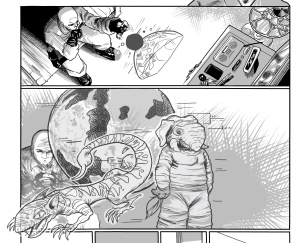
Jerry Bennett drawing, printed with permission.
Early in his career, when Bennett’s “real job” was working at a door store, he did picture books and portraits as a side job. His big break came when he designed a Ghost Busters/Star Wars t-shirt design.
“That was when the Internet was still new. I sold 3,000 shirts in 24 hours. Someone said, ‘Your image went viral,’ and I asked, ‘What does that mean?’”
Now Bennett sees his drawing skills coming together, because many children’s books are starting to rely on comic book style art. However, many adults are familiar with Bennett’s art. Last year, he created a popular illustration of the Thunder basketball team for the cover of the Gazette and an Avengers design for the cover of the Oklahoma Humanities magazine.
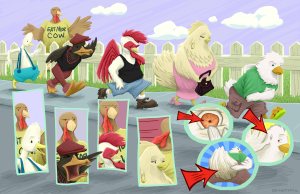
Jerry Bennet drawing, printed with permission.
Don’t be surprised to see Bennett at the zoo with his sketch book and fellow artists. He’s found that the zoo is a great location for “sketch crawls.” Artists go from exhibit to exhibit, drawing animals and creating story ideas.
“I think all kinds of artists are inspired by animal life and nature,” Bennett said. “My next goal is to write and illustrate a graphic novel about alien cats!”
Cliff Casey, Pencil Portraits
Sometimes people cry when they see Cliff Casey’s artwork. That’s because Casey (Norman) specializes in drawing favorite animals and special moments in people’s lives.
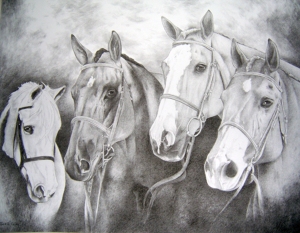
Cliff Casey horse drawing, printed with permission.
“I did a dog portrait for a client at Christmas. He said his wife cried when she saw the gift, because the dog’s facial expression was captured exactly.”
Casey works from photographs, sometimes combining people, animals, or locations together into one scene.
The zoo recently commissioned Casey to paint a portrait for Byron J. Gambulos, upon his retirement from the Zoological Trust. Gambulos and his wife, Patricia, had their first date at the zoo in the 1940s. Using an early photograph of 1940s visitors and the zoo’s original entrance, Casey recreated that special moment on canvas.
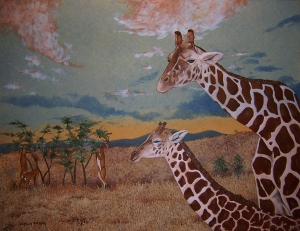
Cliff Casey giraffe painting, printed with permission.
Casey has worked as a graphic artist at the zoo for 14 years. He really enjoys creating two and three dimensional artwork. Right now he’s carving a new sign for the Dan Moran Aviary out of a sign material that looks like wood.
“When I’m doing animal art, I take a lot of research photos at the zoo, looking to see how an animal has its head or body positioned.”
He nearly went to college to train as a park ranger, until a counselor talked him into going to art school instead. Now, Casey’s wildlife illustrations of turkey, deer and bears are published in many sportsman magazines.
“I grew up in the woods and on the lake,” Casey said, “but I can’t get outside or go fishing as much anymore, so drawing nature gives me a chance to connect with nature.”
(Note: This is a longer version of the text, as seen first in ZooSounds Summer 2013, printed with permission)


 The most famous zoo baby is Malee the elephant. Her birth in 2011 was historic—the first elephant baby for Oklahoma City! The community fell in love with her, and visitor traffic increased by 150,000 people during her first few months. In December, she was joined by a sibling.
The most famous zoo baby is Malee the elephant. Her birth in 2011 was historic—the first elephant baby for Oklahoma City! The community fell in love with her, and visitor traffic increased by 150,000 people during her first few months. In December, she was joined by a sibling.
 Beyond the famous babies, the zoo is host to all sorts of animal younglings. Raising a flock of flamingo chicks is a bi-annual project for the zoo’s bird keepers. Flamingo eggs are gathered up and incubated, and then the fluffy hatchlings are cared for until spring, when they are integrated into the flock. In this case, because of our native rat snake population our best option for our flamingos is to pull their eggs and hand-raise chicks.
Beyond the famous babies, the zoo is host to all sorts of animal younglings. Raising a flock of flamingo chicks is a bi-annual project for the zoo’s bird keepers. Flamingo eggs are gathered up and incubated, and then the fluffy hatchlings are cared for until spring, when they are integrated into the flock. In this case, because of our native rat snake population our best option for our flamingos is to pull their eggs and hand-raise chicks.
 Another change in practice was the elimination of the zoo nursery. Visitors really enjoyed looking through glass windows at rooms full of baby animals, but zoo professionals now advocate that offspring stay with their parents whenever possible. Every endangered species born into a zoo is part of a viable effort to conserve the species for the future.
Another change in practice was the elimination of the zoo nursery. Visitors really enjoyed looking through glass windows at rooms full of baby animals, but zoo professionals now advocate that offspring stay with their parents whenever possible. Every endangered species born into a zoo is part of a viable effort to conserve the species for the future.








